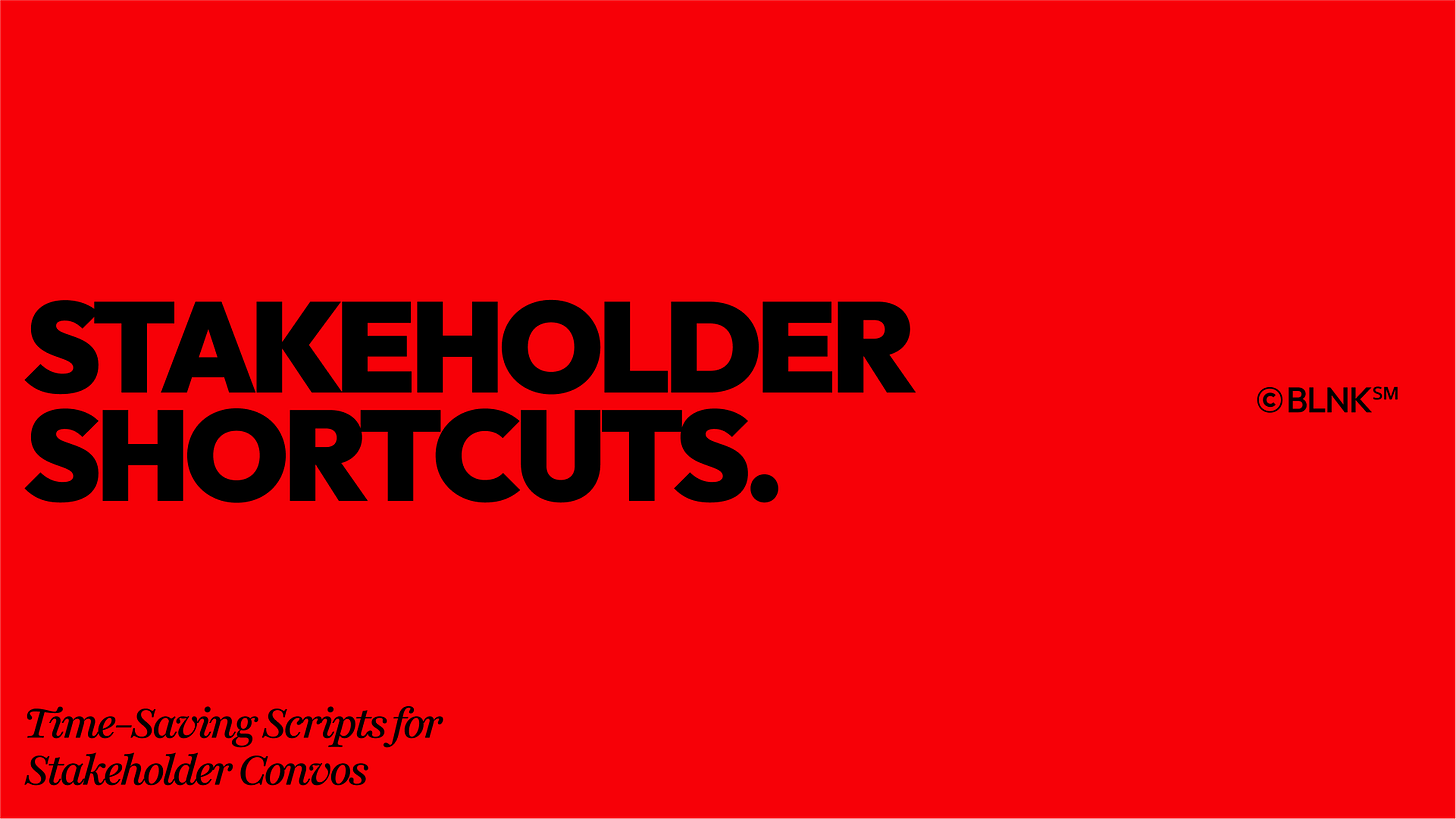Stakeholder Shortcuts—Time-Saving Scripts for Designers
After 8+ years of working in corporate design teams, I’ve discovered something important:
The way you talk to stakeholders can either speed up your projects or slow them down completely.
Let’s face it, stakeholder communication can be a pain. You’re stuck in endless loops of meetings, feedback sessions, and email chains, and before you know it, your creative time is gone. But it doesn’t have to be this way.
That’s why I created Stakeholder Shortcuts: Time-Saving Scripts for Stakeholder Convos—a guide designed to help you cut through the noise, say exactly what you need to say, and get back to what you love: creating. These are copy-and-paste scripts that act as your fast track to smoother conversations and less wasted time.
But, why?
If you’re an in-house designer working in a corporate environment, you know the deal. Your day is packed with:
Meetings.
Emails.
Updates.
Feedback requests.
It’s exhausting. All this back-and-forth pulls your energy away from what you really want to be doing: designing.
Here’s the problem: Communicating with stakeholders isn’t just time-consuming, it’s mentally draining. You get stuck explaining the same things over and over, dealing with unclear feedback, or managing unrealistic expectations. Suddenly, your creative focus is gone, and you’re left wondering where the day went.
This guide is here to fix that.
By giving you ready-made, copy-and-paste scripts for common situations, you no longer have to struggle with finding the right words. These shortcuts give you back control of your time, help streamline communication, and free up mental space for the work that actually excites you.
An easy copy-and-paste scripts
Stakeholder Shortcuts isn’t just another generic guide. It’s practical, it’s fast, and it’s built for in-house designers like you. Whether you’re dealing with vague feedback, managing tight deadlines, or setting clear expectations—these scripts have you covered.
These scripts are divided into 6 main sections I feel we designers struggle the most when communicating with SH*:
ONBOARDING SH INTO DESIGN PROCESS
SH RELATIONSHIPS
SH WRANGLING
SH FEEDBACK PROCESS
SH EDUCATION
SH CONFLICTS
(*SH= Stakeholder)
A few examples you’ll find inside:
How can you guide the team to provide actionable feedback?
Hi {Team},
To make our design reviews more effective, please provide actionable feedback by:
Being specific: Point out exactly what you're referring to.
Aligning with objectives: Relate your comments to our project goals.
Explaining why: Share the reasons behind your suggestions.
Offering solutions: If you have ideas, please share them.
Your detailed input will help us improve the design efficiently.
Thanks,
{Your Name}
The timeline isn't clear; how do you set expectations?
Hi {Stakeholder Name},
To keep our project on track, here's the proposed timeline:
Step 1: Brief Submission (Completed): {Date}
Step 2: Project Kick-off Meeting: {Date}
Step 3: Moodboard Presentation: {Date}
Feedback Deadline: {Date}
Step 4: Design Presentation Call: {Date}
Feedback Deadline for Revisions: {Date}
Step 5: Final Deliverables Shared: {Date}
Step 6: Feedback & Review: {Date}
Meeting these dates helps ensure a smooth process and timely delivery. If you have any questions or need adjustments, please let me know.
Thanks,
{Your Name}
There's frequent escalation beyond your authority; how do you manage this?
Hi {Stakeholder Name},
I've observed that some issues are being escalated directly. To keep things efficient, could we establish a clear communication path? This way, we can address concerns promptly within the team before escalating.
Appreciate your understanding.
Best,
{Your Name}
How to use?
You have full permission to copy and paste these scripts directly into your communications with stakeholders. Want to personalize them? Go for it! Whether you like adding emojis, using a casual tone, or keeping it formal, the scripts are flexible.
Pro Tip: Customize your sign-off. Are you a “Best,” “Cheers!,” or “Talk soon” type of person? Make it yours. If you’re working as part of a team, swap “I” for “we” to keep things collaborative.
At the end of the day, these scripts are here to help you communicate clearly, save time, and still stay true to your personal style.
Why Communication is important
I know first-hand how overwhelming corporate design can be—constantly balancing creative work with managing multiple stakeholders. But here’s what I’ve learned: Effective communication doesn’t just save time, it positions you as a leader. When you master clear, concise stakeholder communication, you take control of your projects and can focus on what truly matters—creating designs that make an impact.
Let’s streamline your conversations so you can get back to doing what you love.
Let me know what you think of the scripts, and feel free to share your own challenges with stakeholder communication. I’m here to help you take your design process to the next level.
Until next time, Blanca☺︎






